What is shifu?
Shifu is the Japanese word for cloth woven with hand spun washi paper yarn.
How did you get started?
I became interested in shifu many years ago, when a close friend showed me some samples she had from a workshop. I was intrigued at the time, but not enough to take a break from basketry. Plus, it looked pretty intimidating to me, and I didn’t think I could do it without a teacher.
Fast forward to about four years ago, when I met weaving instructor, Kate Boyes at the Oregon coast. I spent an afternoon with Kate, and became interested in the possibilities of using paper yarn or cord in my baskets. Under Kate’s guidance, I realized that the process of preparing the paper was not as difficult as I had originally perceived
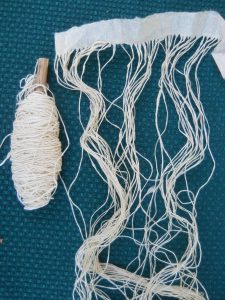
What is the process?
A condensed explanation follows. Since washi paper made for shifu is rather expensive, I started with Thai unryu paper. It’s also made with mulberry fiber. Beginners should purchase 25 gm weight. Your first step is to find the grain of the paper. The paper is folded in a “w” shape, so that you are following the grain.
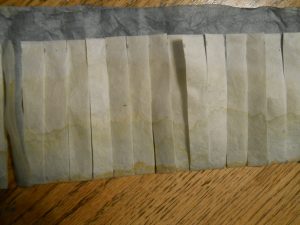
Step #1
The next step is to measure and cut the paper so that it will form a continuous strip. Depending on the weight of the paper, and the project, your strip can be a few millimeters to 1” wide.
Once the paper is cut, it needs to be pre-spun, which is what we are seeing in the first photo. If you are using washi paper that was made for shifu, it has to be moistened in a towel and sit in plastic bag overnight. Traditionally, pre-spinning is done on a rough surface or cement blocks. https://www.youtube.com/watch?v=Qm8WPhowKwk
After pre-spinning, the paper is torn at the edges and spun on a spinning wheel, drop spindle, spindle bobbin winder, or other spinning device.
If you are using Thai unryu, I have found that misting (not spraying) with water generally works, depending on the weight and width of your paper strip. There is a lot of trial and error involved. If you overspray, the paper will tear very easily.
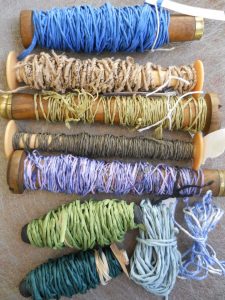
best shifu koyori
When I’m done spinning, I like to wrap my damp paper yarn around a flat basket, or a plastic covered book to dry. I think that it holds the twist better. In my damp climate, I wouldn’t store it all tightly bundled due to mold.
Since I’m mostly making baskets, I don’t do anything further to the yarn. If you are going to use it in a wearable item, you should consider boiling your yarn in the traditional manner.
How can we learn more about shifu?
There are many articles written about shifu. Check out the Facebook page, Paper Threads,Yarns,Textiles https://www.facebook.com/groups/paperthreads/ If you go to the files, you will see a list of books, articles, videos, etc.
Two excellent books have been published. Susan Byrd’s Song of Praise for Shifu, and Kigami and Kami-ito: Japanese Handmade Paper and Paper Thread by Hiroko Karuno.
Anything else?
You can decorate your paper before or after. I’ve experimented with dyes, inks, markers, gold leaf, and more. One of my favorite things to do is to write some words of inspiration, so that I’m adding a hidden message within my work. You can also dye your yarn.
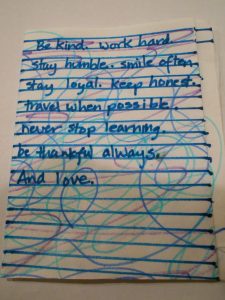
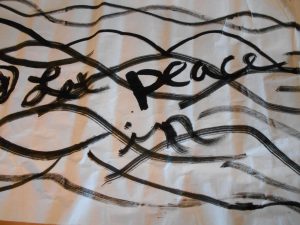
Works with Paper Yarn
A few years ago, I found this photo online, and it prompted me to spin and weave a pair of slippers.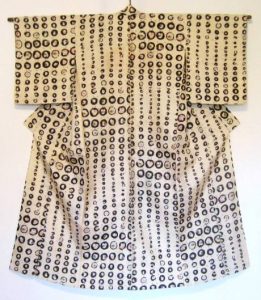
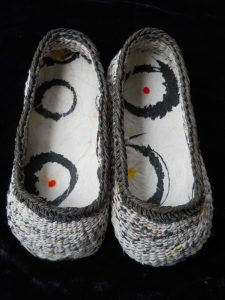
I painted a piece of Thai unryu paper with similar design and colors. Then I prepared most of it for the yarn, leaving the rest for the soles of the slippers.
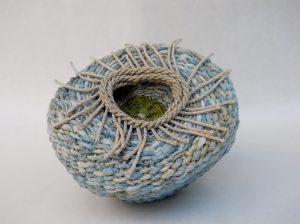
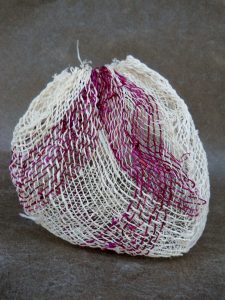
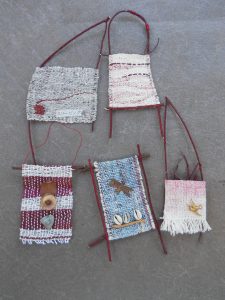
Shifu- small weavings
A small variety of samplers. The piece in the upper left corner is made from Japanese newspaper. the others are a mixture of cotton warp threads with Habu paper yarn or Thai unryu yarn.
********************************************************
Donna has been creating fiber art and teaching workshops since 1986. As a former park ranger, she has lived in some of the most beautiful places in the western U.S. Although she is now living in an urban area, her pieces often reveal the spiritual and physical connection she has developed.
Interests in Japanese and Native American cultures have also been a large influence in her baskets and other woven pieces. She is an advocate of life long learning, and has taken many basketry workshops, along with ceramics, jewelry, and weaving. This background has allowed her to develop a unique, personal style, which she enjoys sharing with others.
Donna can be contacted at d2crispin@aol.com for more information.